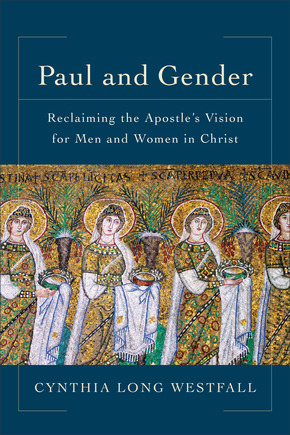The Head of the Household Called to Women's Work?

December 16, 2016
What do you think about when you hear a book title like Paul and Gender? Maybe your first reaction is to wonder who would be writing on this topic, and you immediately pinpoint that this book must be written by an egalitarian---it is, by the way. Another related tendency may be to read this title as a book about Paul and women, and it is. But it’s also about men. It’s about Paul and gender, which includes both women and men, but nothing about women trapped inside men’s bodies, or any of the other 71 gender options recognized by Facebook. I learned a lot  from Cynthia Long Westfall’s academic contribution to this topic.
from Cynthia Long Westfall’s academic contribution to this topic.
 from Cynthia Long Westfall’s academic contribution to this topic.
from Cynthia Long Westfall’s academic contribution to this topic.Yes, I learned from an egalitarian. No, I am not an egalitarian. No, she didn’t convince me that Scripture supports the ordination of women. But her expositional, linguistic, and historical work sharpened my understanding of Paul and gender. And I wish I could read more of this quality in complementarian work as well. This isn’t a review of the book, in which case I would want to interact with some of the egalitarian teaching in it. Today I want to share one snap shot in the book. I do hope to write more of my understanding of what I see as an overall biblical argument for ordination of certain, qualified male elders later. But here I would like to highlight areas where complementarians can be sharpened. And one of those areas is in how we teach on Eph. 5:25-33.
While many will affirm that Paul is calling men to a sacrificial leadership in this text, maybe even using a term like servant-leader, the emphasis is usually placed on the wife’s call to submit to her husband. And so the teaching urges husbands to be Christ-like and wives to submit to their authority. This is presented as biblical manhood and womanhood. (However, as one stand-out complementarian example, Greg Beale is not so reductionist.) But Westfall teaches that in this passage men are called to model Christ by doing women’s work.
Westfall elaborates on the context of gender roles in the Greco-Roman world in which women were subjected to the sphere of low status domestic work. Women’s work was comparable to slave’s work. While women did have authority in the domestic sphere, men dominated the work in the public sphere. This is what is so fascinating about what Paul says in Eph. 5:25-33.
The nature of Christ’s actions toward the church and the husband’s action toward the wife in Ephesians 5:25-33 would have been understood as "women’s work." The representation of the church as the bride would have been effeminate, according to Greco-Roman values. Consequently, Paul is subverting male privilege in the home and church. He promotes a model of servanthood and low status, consistent with the humility of Christ’s incarnation, precisely for men, who have power and position in the Greco-Roman social system. (23)
…When the husbands are addressed, the male role is not described in terms of the expected categories of responsibilities in the public domain of warrior, protector, provider, and patron. Instead, the imagery quickly shifts to household scenes of bathing, clothing (spinning and weaving), laundering, feeding, and nurturing, because Jesus is depicted as providing these services for the church, which is both his bride and his body. Bathing, spinning, weaving, and laundering were perpetual household needs, but the cleansing with water in 5:26 may include a figurative reference to a bride’s prenuptial washing, and the clothing and laundering (including spot removal, washing, and ironing) in 5:27 may refer to obtaining and maintaining a bride’s wedding clothes.
This description of Jesus’s sanctification of the church is often interpreted as being fulfilled in the future culminating marriage of the Lamb, but it is also an allusion to the expended metaphor of Yahweh’s past adoption and marital covenant with Israel (Ezek. 16:1-13). At birth and at puberty, neither a midwife nor a servant had love, pity, or compassion to care for the newborn Israel or to cleanse and cloth Israel when she reached puberty, so Yahweh performed these services for her.
The force of the metaphor must not be lost or confused: both the Old Testament imagery and Paul are portraying God, Christ, and the husband as performing services for a bride or wife. These services are constrained to the domestic realm through either the nature of the acts or the comparison to the personal care of the husband’s own body. (56-57)
Not only are female metaphors applied here for how a man is to love his wife, but also, as part of the church men are called Christ’s bride, adorned in feminine wedding garments. Westfall even suggests that in referring back to Gen. 2:24 and using that same metaphor of one flesh between Christ and the church, Paul “reverses the shame that was directly connected with the female’s sexual function in the Greco-Roman culture,” from one who was “shamed and dominated through penetration,” to “recast the female gender positively, in a way that reflects the evaluation of a woman in the creation account (Gen. 1:31)” (58-59).
It’s interesting how in an attempt to maintain biblical gender distinction many in our evangelical and Reformedish culture tend to stereotype roles for headship and submission, where Paul actually turns stereotypes upside down by using the very language of the culture to “equip male and female believers to follow Christ”:
Women needed to make adjustments to their identity and function in order to exercise power, conduct spiritual warfare like a warrior and a gladiator, and pursue spiritual goals like an athlete [something she addresses earlier in the chapter with biblical texts using male metaphors applied to all believers]. They needed to grow up to maturity rather than metaphorically remain in immaturity under a guardian. Men (including Paul) needed to make adjustments to their identity and function in order to recognize vulnerability, nurture other believers, quell aggression, and follow Christ in humility, suffering, and submission. We will see that Paul recognized gender differentiation, but that he continually referred to the creation account for his understanding and argument about how male and female operate in the ‘already and not yet’ eschatological Christian community. (59)




